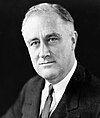Charles Edison
Charles Edison | |
|---|---|
| 42nd Governor of New Jersey | |
| In office January 21, 1941 – January 18, 1944 | |
| Preceded by | A. Harry Moore |
| Succeeded by | Walter Evans Edge |
| United States Secretary of the Navy | |
| In office January 2, 1940 – June 24, 1940 | |
| Preceded by | Claude A. Swanson |
| Succeeded by | Frank Knox |
| Personal details | |
| Born | image Charles_Edison.jpg August 3, 1890 West Orange, New Jersey |
| Died | July 31, 1969 (aged 78) New York City |
| Resting place | image Charles_Edison.jpg |
| Political party | Democratic |
| Spouse | Carolyn Hawkins |
| Parent |
|

Charles Edison (August 3, 1890 – July 31, 1969), son of Thomas Edison, was a businessman, Assistant and then United States Secretary of the Navy, and served as the 42nd Governor of New Jersey.
Biography
Born at his parents' home, Glenmont, in West Orange, New Jersey, he attended the Hotchkiss School in Lakeville, Connecticut. He married his college sweetheart Carolyn Hawkins on March 27, 1918. They had no children. For a number of years Charles Edison ran Edison Records. Charles became president of his father's company Thomas A. Edison, Inc. in 1927, and ran it until it was sold in 1957, when it merged with the McGraw Electric Company to form the McGraw-Edison Electric Company. Edison was board chairman of the merged company until he retired in 1961.[1]
On January 18, 1937, President Roosevelt appointed Charles Edison as Assistant Secretary of the Navy, then as Secretary on January 2, 1940, Claude A. Swanson having died several months previously.[2] Edison himself only kept the job until June 24, resigning to run his gubernatorial campaign. During his time in the Navy department, he advocated construction of the large Iowa-class battleships, and that one of them be built at the Philadelphia Navy Yard, which secured votes for Roosevelt in Pennsylvania and New Jersey in the 1940 presidential election; in return, Roosevelt had BB-62 named the USS New Jersey.[3]
In 1940, he won election as Governor of New Jersey, running in reaction to the political machine run by Frank Hague, but broke with family tradition by declaring himself a Democrat. As governor, he proposed updating the New Jersey State Constitution. Although it failed in a referendum and nothing was changed during his tenure, state legislators did reform the constitution later.[1] In 1948, he established a charitable foundation, originally called "The Brook Foundation", now the Charles Edison Fund.[4]
Between 1951 and 1969, he lived in the Waldorf-Astoria Hotel, where he struck up a friendship with Herbert Hoover, who also lived there.[5] In 1962, Edison was one of the founders of the Conservative Party of New York State. [6]
In 1967, Edison hosted a meeting at the Waldorf-Astoria in New York that led to the founding of the Charles Edison Youth Fund, later the Charles Edison Memorial Youth Fund. Attending the meeting were Rep. Walter Judd (R-Mn), author William F. Buckley, organizer David Jones, and Edison's political advisor Marvin Liebman. The name of the organization was changed in 1985 to The Fund for American Studies [1], in keeping with Edison's request to drop his name after 20 years of use.
His personal mascot was the owl, and he collected objects depicting owls. Charles Edison died on July 31, 1969 in New York City. [7] He is buried in Rosedale Cemetery in Orange, New Jersey.
See also
References
- ^ a b ""GEDIS.pdf"" (PDF). Retrieved September 23.
{{cite web}}: Check date values in:|accessdate=(help); Unknown parameter|accessyear=ignored (|access-date=suggested) (help) - ^ Secretaries of the Navy, Naval Historical Center. Accessed August 6, 2007.
- ^ Comegno, Carol. "Historian details the role politics played in battleship's creation", Courier-Post, January 6, 2000. Accessed May 27, 2007. "Professor Jeffery Dorwart, of Rutgers-Camden said the ship was named after the state by President Franklin Roosevelt to repay a political debt to Charles Edison, the son of inventor Thomas Edison."
- ^ ""Charles Edison"". Retrieved September 23.
{{cite web}}: Check date values in:|accessdate=(help); Unknown parameter|accessyear=ignored (|access-date=suggested) (help) - ^ John D. Venable, Out of the Shadow: the Story of Charles Edison (Charles Edison Fund, 1978), p. 271.
- ^ Niels Bjerre-Poulsen, Right Face: Organizing the American Conservative Movement 1945-65 (Museum Tusculanum Press, 2002), p. 143. (ISBN 978-8772898094)
- ^ "Charles Edison, 78, Ex-Governor Of Jersey and U.S. Aide, Is Dead". New York Times. August 1, 1969.
{{cite news}}:|access-date=requires|url=(help); Check date values in:|date=(help); Cite has empty unknown parameter:|coauthors=(help)
Further reading
- Richard J. Connors, State Constitutional Convention Studies, #4: The Process of Constitutional Revision in New Jersey: 1940-1947. (New York: National Municipal League, 1970).
- Out of the Shadow: the Story of Charles Edison (Charles Edison Fund, 1978). (ASIN B0006CZSHW)
External links
- Biography for Charles Edison (PDF), New Jersey State Library
- New Jersey Governor Charles Edison, National Governors Association
- Charles Edison Fund: Includes a picture of Charles Edison
- The Pragmatic Populism of a Non-Partisan Politician: An Analysis of the Political Philosophy of Charles Edison
- Fund for American Studies, formerly the Charles Edison Memorial Youth Fund[2]

